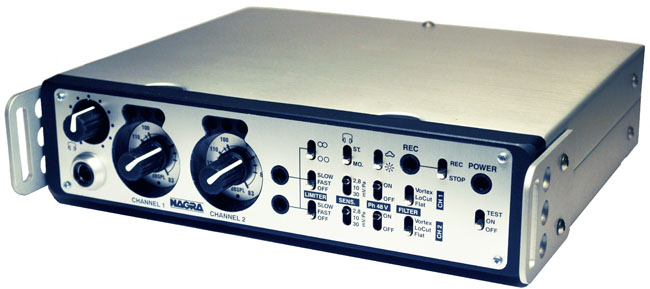Search the Community
Showing results for tags 'preamplifier'.
-
A provisional operating manual for the Nagra EMP preamp fell into my hands so I thought I would post what I learned. I haven’t yet played with the device itself but I could borrow an example if anyone is interested to know more. (I have worked with essentially the same preamps on a Nagra VI so I’m generally familiar with the source.) Briefly, it is a two-channel preamp, with built-in recording capability, designed as a stand-alone device or as a companion to the Nagra VI recorder. When used with the Nagra recorder, it draws its power from that source. As a stand-alone it can be powered either through a Hirose connector (accepting 9V- 13V) or from four internal AA batteries. Its size is very close to the Sound Devices Mix-Pre2. At 7.5 x 2 x 6.9” the Nagra is slightly smaller than the SD unit but only slightly. Weight, with batteries, is 2.2 pounds. According to Nagra, the preamps in the EMP are essentially the same as those used in the Nagra VI recorder. That would make them among the very best available in any portable device. Frequency response runs from 10 Hz to above 40 kHz and is flat from 20 Hz. Nagra claims a S/N of better than 114 dB. The pots are a match to the Nagra VI design. While there is no full-scale meter, there are three colored lights immediately above each knob. They are programmed at the factory to come on RED @ -1 dBFS, YELLOW @ -9 dBFS and GREEN @ -30 dBFS. Internal switches permit the user to re-set the lights to suit their own preferences. Phantom power is available, of course, and there are built-in limiters that may be engaged or disengaged for each channel individually. One can also choose a fast or slow attack time. Lights, independent of the three lights above each channel fader, indicate limiter activity. Two low-end filters may be independently engaged for each channel or one may operate flat. The low cut filter has no effect on program material above 60 Hz. Below 60 Hz, the graph line plunges like a diver. This is a welcome addition to the preamp design, providing a steep reduction in low frequency response for wind and handling noise without any effect on the deepest bass voices or even most instruments. The second position, called Vortex, provides a gentle slope beginning at a higher frequency and yielding about 4 dB of reduction at 100 Hz and more than 10 dB at 50 Hz. This is designed for effective wind control in blustery conditions with minimal effect on low voices. Nagra makes a point of emphasizing that the filters are hardware designs and not implemented through software. While the ability to change slopes and settings is sacrificed, the effectiveness of software filters is limited because they come later in the chain. With low frequency rumble, like wind noise, the circuit may already overloaded before the software filters come online. Inputs and outputs are via standard XLR connections. Output levels are adjustable but only by changing the positions of internal jumpers. The EMP has a built in recording capability. Files are saved to an internal 2 GB flash memory and may be ported to a computer through a USB connection. Recordings can be made at 32, 44.1 or 48 kHz. Oddly, only 16-bit recording is supported and there is no mention of timecode. The internal recording seems to be intended more as a back-up capability than as a primary function. This seems a nice addition to a Nagra VI. In a compact box it provides two additional channels of microphone inputs with operational characteristics that match the recorder. As a stand-alone device, I expect its attraction will be limited. I don’t know the cost but I would expect Swiss precision to be more expensive than the competitive Sound Devices MixPre. While I expect that the Nagra’s performance is probably superior, I wonder if that’s a distinction one would hear in most film applications. On the other hand, for people doing music recording, it offers the best performance in a small and user-friendly package. David
- 11 replies
-
- Nagra
- preamplifier
-
(and 1 more)
Tagged with:



